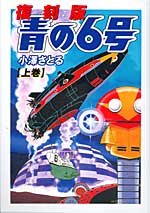by Luis Reyes
|
A groundbreaking achievement, "Blue Submarine" succeeds in different ways for different people and, consequentially, fails in different ways for different people. But it provokes a response across the board.
On the heels of Osamu Tezuka's watershed "Astroboy," the 1960s introduced a darker manga to the fray, Satoru Ozawa's "Aonorokugo," or "Blue Submarine No. 6" as it's referred to stateside. Packed with political tension, sea monsters and exciting submarine battles, Satoru's vision never became an animated series. No studio was willing to tackle the manga's complexity, especially with the riches promised by an American television market with far tamer tastes. Over thirty years later, Japan's Gonzo Studio braves the task and churns out an anime version of "Aonorokugo" using state-of-the-art computer animation techniques combined with cutting edge cel animation. But more than it's technical innovations, the Gonzo project's retention of the manga's thematic depth, enhanced by the storytelling skills of scriptwriter Hiroshi Yamaguchi and director Mahiro Maeda, distinguish "Blue Submarine No. 6" as a narrative innovation as well. However, across the board, spirited debate about the quality of "Blue Submarine" surfaced from nearly every corner of the anime community, spouting a wide range of opinions that dissected this anime down to its technical minutia. "The combination of 2D and 3D animation was horrible," blasted one irate fan. Another retorted, "This is a pioneering effort - the 2D interacted really well with the 3D environment." "The music didn't match the action," quoth a keen teen. "The music was great," bat a keener. "Kino was annoying;"
"The plot was weak;"
"Zorndyke's plan was never explained;"
"The battle scenes were incredible;"
"Hayami looks like Heero from 'Gundam Wing;'"
"The story was deep;"
"The English dub was bad;"
"The dub was great;"
"I am opposed to dubs in general, but the 'Blue Submarine' dub is pretty good;"
"All in all I'd have to say that this is one of the best anime I have ever seen."
Needless to say, the fan community had fractured over "Blue Submarine." Now with a run on the Cartoon Network, a Blockbuster video rental release and a Bandai cinematic version coming out on DVD and VHS, "Blue Submarine" has done what few other anime have, broken the mainstream market. And, even more remarkable, it has done so without coming in with a full 26 episode season like "Dragonball Z" and "Tenchi," without being geared toward a child's demographic and without climaxing in an audience-pleasing conflagration out of which "good" triumphs over "evil." The success of "Blue Submarine," mild though it may be, portends not only a change in the viewing habits of an American audience renowned for sucker-slurping the lowest common denominator, but also a change in the American attitude toward anime, an attitude that once relegated the medium to insignificant sophomoric distractions. From the very beginning, Maeda envisioned the technology as a tool through which to tell a more engaging story. "Because this is a story about a submarine, I thought it would be easy to separate the two worlds," Maeda said in an Akadot interview at Anime Expo 2000. "I thought it would be convenient to film the world outside the submarine in 3D. The small and delicate human interactions would require more attention, the kind of attention that cel animation can bring to a character." The real innovation in combining the disparate animation techniques deferred notice to the troubled aesthetic confluence. But the near perfect interaction of these cel drawn characters in their full computer graphics environment places the "Blue Submarine" design team at the cusp of the computer graphics revolution.
"The Japanese people have a culture of telling stories with pictures," Maeda explains. "When Tezuka Osamu started making anime, he was just trying to make manga with a camera, to try to tell a story with moving pictures, having seen it done by Disney. It was jarring at first, but they used the technology to create a new style, and the younger generations grew up learning how to watch it. Now with the emergence of the video game culture, it opens up a new kind of style. When we first made 'Blue Submarine' the older generations immediately said 'oh, this is mismatching.' But the younger generations who have grown up watching different animation mediums, understood." Maeda goes on to explain how doing "Blue Submarine" was a way to demonstrate how all kinds of disparate elements can work together - old style manga, new style storytelling, conventional anime premise, traditional cel animation and video game-like computer animation. "Animation doesn't have to be a purist art but a combination of the arts, each bringing unique qualities." |


